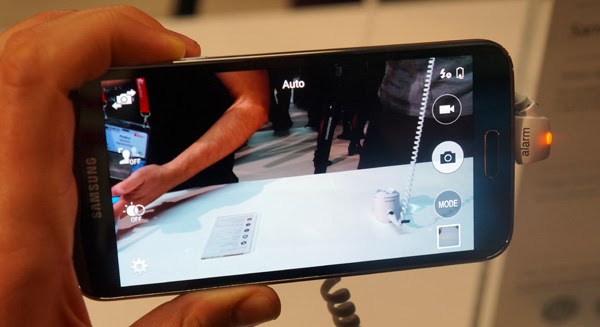Sony
Xperia Z2
Sony
Xperia Z2 release date and price
In the UK the Xperia
Z2 is up for pre-order for a whopping £599 SIM free on Sony's site, while in
Australia it's about AU$899.95 , Rs.60999 in INDIA and in the US you're looking at around $600.
The Xperia Z2's
global release date is April 2014 and the handset has been announced on UK
networks O2, Three, Vodafone and EE as well as by retailers such as Carphone
Warehouse.
Xperia
Z2 specifications
The Sony Xperia Z2
includes Sony Digital Noise Cancelling – a first in a phone – and as is
becoming the norm for Sony, it's dust- and waterproof as well.
The handset is one
of the first (along with the One M8 and Galaxy S5) to be powered by the
Qualcomm Snapdragon 801 processor and it boasts four 2.3GHz Krait CPUs in
addition to 4G LTE, 3GB of RAM and a high capacity 3,200mAh battery, which in
combination with Sony's Battery STAMINA mode should keep it going for quite
some time.
On the storage front
there's 16GB built in along with a microSD card slot which supports cards of up
to 64GB.
As you might expect
from any worthwhile new flagship phone, it's also running Android KitKat with Sony's light interface skin placed on top.
That makes it a
moderate upgrade over the Sony Xperia Z1, which has a 2.2GHz Snapdragon 800
processor and 2GB of RAM.
Xperia
Z2 camera and audio
The Z2's key
technology sell is the ability to shoot 4K video, so that's four times the pixels
of HD and twice the resolution at - 3,840 x 2,160 pixels at 30fps.
The camera is a
20.7MP unit, with the mobile version of the proven Exmor RS image sensor and
Bionz processing engine alongside Sony's G Lens. Using built in apps, you can
also shoot Timeshift video, while there's also an AR app, too.
The Timeshift video
mode lets you shoot in 120 frames per second and select individual scenes to
slow playback
Another new app
enables you to defocus the background and adapt a shallow depth of field – you
can capture two photos at different focus settings and blend them together.
Backing up the main
camera there's a 2.2MP snapper on the front which can shoot 1080p video at
30fps.
Sadly there's no
optical image stabilization, but the Xperia Z2 does have SteadyShot digital
image stabilization, which similarly aims to counter camera shake.
You can also buy an
additional STM10 stereo microphone should you need enhanced sound quality for
shooting 4K video.
Speaking of sound,
Sony's put the speakers on the front of the handset this time around, aiming to
muscle in on the HTC One's territory with
what it's calling S-Force Front Surround.
Sony's MDR NC31EM
noise cancelling headset comes bundled with the handset and unfortunately you
have to use this specific headset if you want to take advantage of the fancy
noise cancelling features of the phone.
Xperia Z2 display
The 5.2-inch IPS LCD
Triluminos display is Full HD 1080 x 1920 with a pixel density of 424 pixels
per inch. The Xperia Z2 uses Sony's X-Reality technology, to optimize colors,
contrast and sharpness while reducing noise.
Sony is also
claiming it has the best color reproduction of any smartphone on the market
with its Live Color LED tech.
Our full review will
put that claim to the test, but it's certainly an impressive display,
particularly in comparison to the Z1, which looks washed out and lacking in
detail when put side by side with this.
Xperia
Z2 design
At 8.2mm thick and
163g, the Z2 is 0.3mm thinner than the Sony Xperia Z1 and 7g lighter, despite
having a larger screen and more powerful innards.
It's an evolution of
the same aluminum design, which Sony calls OmniBalance.
In fact it looks
almost identical to the Xperia Z1, with the same metal edging, glass back and
large bezels above and below the screen.
Like the Z1 it's
also dust resistant and waterproof to IP55 & IP58 standards, allowing it to
be submerged for up to 30 minutes in water 1 meter deep.
Xperia Z2 interface and features
The Xperia Z2's interface is similar to that of the Z1, though it comes
with Android 4.4.2 KitKat so it's bang up to date.
The handset also
has a few new features hidden away in its menus. There's 'Smart Backlight
Control' for one, which will keep the screen on while you're looking at it,
just like Samsung does with Smart Stay.
Then there's the
ability to double tap the screen to wake it up, much like LG's KnockON feature
and it's also possible to answer or reject calls with hand gestures.
The Sony Xperia Z2 has also inherited Glove Mode from the Xperia Z1
Compact, allowing you to operate it
while wearing gloves and there's a Simple Home option, which, well, simplifies
the home screen and uses bigger icons, making it ideal for smartphone virgins
and visually impaired users.
Read onto the next page for our earlier Sony Xperia Z2 rumors.
either side of the screen.
Sony
Xperia Z2 power
While a 2K screen
would help the Sony Xperia Z2 stand out, when it comes to power things appear
to be a little less exciting.
Reports are
centering around the same 2.3GHz quad-core processor which you'll find in the Xperia Z1 and Z1 Compact.
That's not to say
the Xperia Z2 will be under-powered - far from it in fact - but we were hoping
to see perhaps an octa-core chip inside the next Sony powerhouse. Of course
that is still possible, we'll just have to wait and see.
In terms of RAM inside
the Sony Xperia Z2 it seems the handset is inline for a boost here, with 3GB
apparently on the cards.

-580-90.JPG)
-580-90.JPG)


-580-90.JPG)




-580-90.jpg)



-580-90.jpg)


























